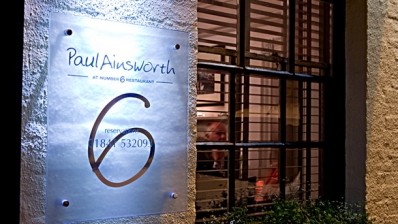Front-of-house focus: The new order of service

Reports of the death of fine dining have been greatly exaggerated, as Mark Twain might have put it, but there’s little doubt that the world’s dining rooms have undergone a major change over the past decade.
Few would argue that Noma is not a fine-dining restaurant but these same people would also acknowledge that the décor, staff attire and approach to front of house at the former World’s Best Restaurant is a million miles from what you might find at others held in similarly high regard, Alain Ducasse’s shamelessly opulent Le Louis XV, for example.
Not so long ago, the service at top-flight restaurants was remarkably similar but now there’s no one-size-fits-all approach. Service styles are changing in restaurants across the UK service too, but it’s much more nuanced than ‘goodbye fine dining, hello casual’ with the removal of table cloths and the dishing out of Converse to waiting staff.
Casual restaurants are borrowing elements from more upscale ones, and the most traditional of dining rooms are turning to much more informal operations for inspiration, as chefs and restaurateurs try to create the perfect dining atmosphere.
So what is the key to faultless front of house? What tricks can the old guard learn from the new breed of casual yet top-end restaurants and what can these businesses take from their more formal cousins? We gathered seven of London’s foremost front-of-house operators to lift the lid on how they are running the dining rooms of today.
Johnny Smith: The Clove Club
Location: Shoreditch
Service style: Informal and unfussy
Dining room: Smart but utilitarian with white walls and an open kitchen. No tablecloths.
Staff wear: Designer jeans and Oxford shirts
Customers wear: Jeans, trainers
The service style at this modish east London restaurant may be low key, but its status as one of the best places to eat in the country – along with a Michelin star, the restaurant is currently ranked 26th on The World’s 50 Best Restaurants list – means front of house needs to be a lot more organised than most diners probably realise.
“The challenge for us is giving people a great and memorable experience in an informal manner,” says co-owner and co-restaurant manager Johnny Smith. “We may not have tablecloths but a lot of things have to happen before and during service to make it run smoothly.”
Smith clearly has a certain admiration for old-school table-side theatrics and has worked with his co-owners – chef Issac McHale and fellow front-of-house professional Daniel Willis – to roll a handful of more technical elements into the restaurant’s service.
“The range of experiences on offer is the primary reason the London dining scene is such a great success story. A sense of occasion and theatre is an essential part of the top-end restaurant experience,” says Smith. To this end, The Clove Club serves a course that starts with a tasting of a 1908 vintage madeira. The guests drink some and discuss it with their waiter. The glass is then topped up with a hot duck consommé.
“It’s a slightly stripped back interpretation of silver service, but it’s reliant on the same skills.”
The glasses of madeira arrive on a silver tray, which comes close to tongue-in-cheek territory given the casual feel of The Clove Club’s dining room. Successfully incorporating this dish into the guest experience requires staff to tread a thin line between a pomposity that would be completely out of place in Shoreditch and being too cool for school.
Designed by Japanese designer Beams Plus, the staff uniforms are a good-fit for the restaurant’s service style. Smith himself wears a suit and tie, but with accessories that would likely raise an eyebrow at other World’s 50 Best restaurants – today he’s paired his blue tie and pocket square with buttercup-yellow socks and suede ankle boots.
Darren McHugh: The Ledbury
Location: Notting Hill
Service style: Award winning, noted for being very traditional but informal
Dining room: Smart with tablecloths and chandeliers
Staff wear: Smart uniforms
Customers wear: Generally smart attire
The Ledbury is a restaurant of considerable gastronomic ambition – it has two Michelin stars and is currently 14th on The World’s 50 Best Restaurants list – but it’s also a neighbourhood restaurant that welcomes a lot of regular customers.
The way the dining room is run was recently tweaked in order to provide a more personal service and put its most experienced staff centre stage, according to the restaurant’s Dublin-born general manager Darren McHugh.
“People have their own roles and job descriptions but myself, the restaurant manager and the assistant restaurant manager run a small section in tandem with overseeing the dining room as a whole,” McHugh says of the Notting Hill restaurant.
“In many other top-end restaurants the senior people are in the background directing the service and checking up on tables.”
This individualistic approach to running the dining room is described as ‘total football’, in reference to the football tactic in which any outfield player can take over the role of any other player in a team made famous by the Netherlands World Cup squad. If a member of the front-of-house team is pulled away to do another job, they are replaced by another member of staff, thus retaining the dining room’s organisational structure.
Sarah Flyckt: Spring
Location: Somerset House
Service and Style: Breezy and highly personal with staff at all levels encouraged to interact with guests
Dining room: Bright and beautiful with pastel colours
Staff wear: Unusual-looking uniforms from high-profile designer Maureen Doherty
Customers wear: Evening theatre attire
The service at Spring is sophisticated, but it’s delivered in a breezy, relaxed manner that reflects chef Skye Gyngell’s unfussy approach to cooking and the restaurant’s overtly feminine stylistic tack.
The dining room is a stunning high-ceilinged affair with pastel shades and a striking art installation comprised of hundreds of porcelain butterflies, petals and leaves.
Gnarled squashes of various types stand in for flowers on the tables and natural light floods into the restaurant from huge windows overlooking The Strand.
Head maître d’ Sara Flyckt says the principle challenge when Spring opened in late 2014 was the rather grand and masculine space, which was quite a departure for a chef whose most recent gig had been cooking at garden centre Petersham Nurseries.
“The room is amazing. But it would have been quite easy for it to take over and for the staff to be lost and the restaurant become stuffy,” she says. “That’s why we went for such distinctive uniforms and a simple, relaxed and highly personal service style.
The front-of-house team is structured in a relatively traditional way – a maître d’, managers, sommeliers, head waiters and waiters – but everyone is actively encouraged to interact with the customers.
“The waiter’s primary role is to run the food from the pass to the dining room and clear tables but we want everyone that we employ to have their own personality and to be their own person,” says Flyckt.
Anything technical table side, Flyckt says, would jar with the overall approach. “It would be a bit of a mismatch for us. I think the closest we’ve come to that is giving the customers a jug of cream to pour over a dessert.”
Mark Hastings: Dinner By Heston Blumenthal
Location: Knightsbridge
Service style: Formal with some theatrics
Dining room: Large brasserie with a neutral colour palette and open kitchen
Staff wear: Bespoke uniforms with waistcoats and ties that reflect the restaurant’s brasserie-like aesthetic
Customers wear: Suits and open shirts, smart jeans and loafers
Mark Hastings may be suited and booted, but his tablecloth-free dining room has an informal feel that belies its two Michelin stars. “Stylistically speaking, it’s a brasserie albeit a rather high-end one. The service style needs to reflect that,” says Hastings, who has considerable experience in the field of polished yet relaxed service having also run the dining room at Hakkasan.
The restaurant has no dress code which, according to Hastings, causes a few headaches. “I frequently get guests that have dressed up moaning about how casual other diners are. They’re usually the same customers that say: ‘you have two stars, why don’t you have tablecloths?’.”
With a high proportion of international guests (the restaurant is within the Mandarin Oriental Hotel), front-of-house staff must have strong product knowledge and interpersonal skills. “It’s important people realise that a more casual approach does not mean it’s sloppy,” says Hastings, who points out that restaurants like The Ritz and Le Gavroche simply aren’t being opened any more.
“People want that style of dining less now,” he says. However, he stresses that informal dining rooms require just as much choreography as formal ones. With Heston’s name above the door, customers expect some theatrics but the restaurant delivers these in a more subtle way than at The Fat Duck. The kitchen’s dessert of tipsy cake comes with a slice of pineapple roasted in a rotisserie turned by a giant clock mechanism, and a liquid nitrogen ice cream trolley does the rounds in the room. Staff aren’t let loose on the latter until they’ve fully proved that they’ve mastered the art of preparing the ice cream while talking through each stage of the process.
“The service is what elevates the experience to the next level and creates memories. Whatever level it is delivered at – from a coffee shop to a Michelin-starred restaurant – the fundamentals remain the same. Even Heston says service is more important than the food.”
Emmanuel Landré: Le Gavroche
Location: Mayfair
Service style: Formal and French
Dining room: Unashamedly old school
Staff wear: Smart, traditional uniforms
Customers wear: Suits. Men must wear jackets
As a Frenchman, Emmanuel Landré is all too aware of the caricature of the haughty Gallic waiter that roams the floor at old school luxurious restaurants such as that in which he works.
As such, Landré – who is the successor to Le Gavroche’s legendary but now retired maître d’ Silvano Giraldin – works hard to ensure the dining room at Le Gavroche is inclusive and friendly. “Formal service and classicism does not need to be snobby,” he says. “I tell all my staff to always smile at guests and that nothing should be too much trouble. For me, these are the fundamentals of good hospitality.”
Le Gavroche’s dining room is a highly ordered and regimented place that is reliant on strict hierarchies. Commis waiters run trays to the tables, chef de rangs serve the food and head waiters take the orders and do the check backs.
“It’s a traditional structure here,” says Landré. “Given my background in two and three Michelin-starred restaurants it’s difficult to imagine doing it any other way.”
Tom Slegg: Picture
Location: Marylebone/Fitzrovia
Service style: Informal
Dining room design: Sparse and minimalist. Refreshingly low-budget
Staff wear: Casual shirts
Customers wear: Jeans and T-shirts, casual wear
Before going into partnership with chefs Alan Christie and Colin Kelly, Tom Slegg worked in senior front-of-house roles for Anthony Demetre and Will Smith, the chef-restaurateur double act that pioneered affordable, flummery-free dining in the capital.
In his own establishments – one is in Fitzrovia, the other just down the road in Marylebone – he offers an even more stripped back experience that enables the team to serve sophisticated food at a competitive price point by dispensing with many of the trappings that usually accompany high-end dining.
“It’s odd to be reminded about all the different roles within these larger dining rooms,” says Slegg. “At our restaurants, it’s myself or a manager, a bar person, a receptionist and a few waiters. The most front-of-house staff we’d have on a service is six. This means the team has to work very hard to make the experience feel special.”
A big disadvantage with this skeleton crew approach, Slegg says, is that a larger and more structured dining room workforce makes recruitment, training and retention quite a bit easier. “The beauty of grander restaurants is that you can have staff in very junior positions. These people can then be coached and they can climb the rungs. That’s not really possible at Picture. Holding onto great staff is also a challenge because there’s often nowhere for them to go.”
With its no-frills aesthetic, the Picture business lives and dies on its recruitment decisions. “We hire more on personality at Picture than anything else but a little experience is necessary. We don’t have the time to start from scratch with people. We need staff that can be that bit more informal but still behave like a pro.”
Simon Girling: The Ritz
Location: Piccadilly
Service style: Classical, table-side
Dining room: Opulent. Grand and classical with painted murals and gilded fixtures and fittings
Staff wear: Tails and bow ties
Customers wear: Men must wear a shirt and tie. Jeans, trainers and sportswear is not permitted
The Ritz is among a handful of London restaurants that still practise guéridon service, the highly technical service style that sees waiters cook or finish most dishes table side.
It is the rise of the chef as the self-styled culinary artist that has seen guéridon and silver service largely fall by the wayside. Over the past 30 years or so, the kitchen has exerted more and more control on how food is served to the point that now almost everything leaves the pass in its finished state.
“Waiters used to approach the table with empty plates and silver serve the entire meal. We’ve moved on from that now but it’s worth bearing in mind there are real advantages to bringing more of these skills back into the dining room, not least a sense of theatre and occasion,” says The Ritz’s Simon Girling.
At The Ritz, salads are dressed, meat is carved and crêpes suzette are cooked table side, and Girling is particularly evangelical about keeping these traditions and skills alive.
Running a dining room like The Ritz is expensive – it employs a staggering 180 people in its food and beverage department – and the overtly hierarchical structure certainly has the potential to give the proceedings a stiff feel. In most restaurants, the order of service is a single sheet of A4; Girling admits that the document that’s drilled into his staff at The Ritz is a rather longer read.
“The acid test of a front-of-house team is for everyone to swap sections mid-shift. If the flow of service is uninterrupted, you know you’ve got it right. It’s a case of getting lots of tiny things right, such as marking up dockets correctly and being consistent in how you call a table away.”
Girling admits that since he has worked at The Ritz there has been a step change in the way staff are expected to behave. The service style may be formal but the tone in which it is delivered has changed to acknowledge the wider trend for informality in the industry.
“We may be a classically minded fine-dining restaurant, but we work very hard to be friendly. In the past, restaurants of our ilk may have had a reputation for being a bit stuck up. I don’t see that anywhere any more.”
One thing The Ritz is inflexible on is its strict dress code that requires male diners to wear a jacket and tie (the restaurant will lend people items if they don’t have them). It can prove divisive but The Ritz has standards to uphold, says Girling, and this includes what a full dining room looks like.





















